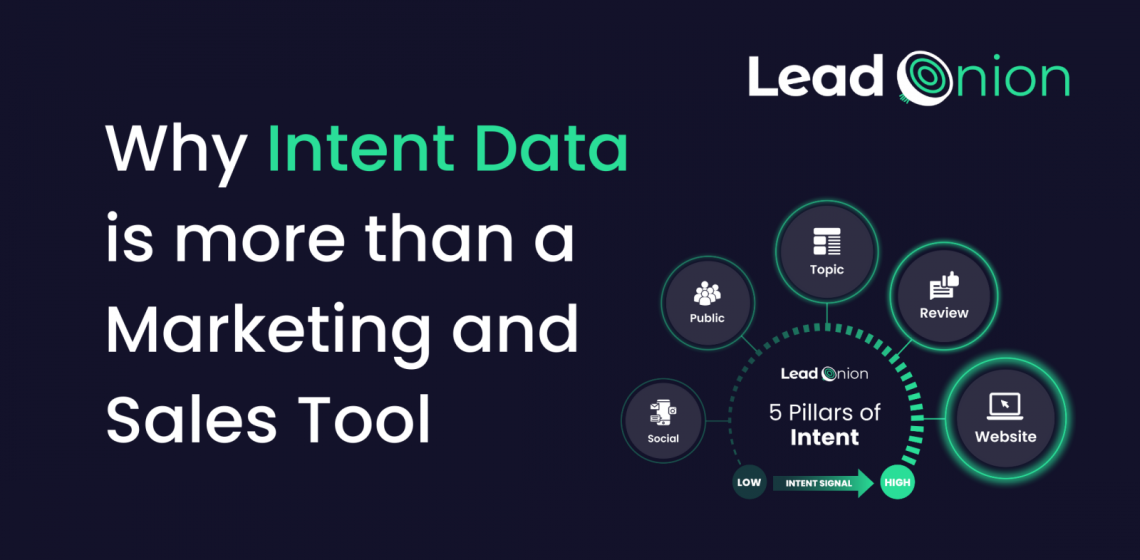Why Intent Data is more than a Marketing and Sales Tool
Intent data has embedded itself as a core sales and marketing tool. According to Gartner, 70% of companies will be using intent data by 2022. But despite the adoption of Intent data, the use cases are still only scratching the surface. Most marketing teams are leveraging Intent data to optimize digital advertising spending, while sales teams are using it to determine what accounts and prospects to reach out to but for most that is where it stops.
As budgets tighten and growth goals remain aggressive, using intent data for customer marketing to help with retention and upsell offers a compelling competitive advantage.
What is intent data and why is it important?
Intent data is the collection of information from across the web that indicates a proxy of interest toward a specific solution, competitor, or problem. Rather than targeting based on gut, spray and pray or prospects finding us, we can now proactively go out and engage with potential customers that have a higher likelihood of buying based on their digital activity.
What are the different sources of intent data?
First-party intent data
These are visitors who have visited your website. They can be both known and unknown and is the most valuable form of intent data because these prospects know your brand.
Second-party intent data
Most traditionally associated with review sites like G2, Trust Radius and Gartner. At its core, it is when a website or service sells its first-party data.
Third-party intent data
Everything that vendors can track from across the web. Depending on your vendor, the data can come from B2B publisher sites, social media sites, data co-ops, and ad exchanges, with each offering its strengths.
Why should intent data be used in customer success?
According to data from HubSpot: It's 6 to 7 times more expensive to acquire a new customer than it is to retain an existing customer.
While a small increase in customer retention can drastically impact the bottom line, happy customers will buy more, and refer more business your way. So it is important to reduce churn and make sure you are keeping customers happy and engaged.
When we think specifically about recurring revenue businesses not only are customer acquisition costs continuing to rise, Net Revenue Retention (NRR) is the compounding engine of growth.
130% NRR means each $10m of ARR becomes $13m ARR the next year, then almost $17M ARR the following year.
But outside of customers raising their hand to buy more, how can we identify opportunities for expansion or proactively prevent churn? Or even more, make sure we are sending them relevant content based on their interests?
It’s likely that customer success teams are leveraging some first-party intent data at the moment to monitor the health of customers, whether through product usage or NPS scores, but that leaves us blind to what’s happening across second and third-party channels where the most relevant signals for customer success lies.
What intent data should your customer success teams be looking for?
The reality is the process of implementing intent for customer success is not dissimilar to implementing for marketing and sales teams.
The first step in bringing any new tool or data set into the fold is evaluating your current process. What does the customer journey look like today? How many customer segments are there (whether that’s by company size, product line or a combination of attributes) and what are the most common reasons why people churn or buy more from you. Once you have understood the current state, you can start to work back towards looking at what additional signals would be useful.
Let’s assume you have a customer marketing program that includes some form of the following, customer and field events, webinars, email nurtures, whitepapers, videos, etc. Each of these channels offers a unique way to interact with customers, and intent data can help ensure you are sending relevant content based on their interests and priorities. For example, assume you sell a sales engagement solution and you see a customer looking at content around cold calling, this would be an opportune time to share any resources you have that would help educate the customer on cold calling. Or if you see a concentration of customers attending a specific event, it could be a great opportunity to get some additional face time and further build your relationship.
.png)
Outside of providing relevant content to your customers, intent data can help you quickly identify signals of potential churn that are happening outside of your owned channels. Intent data can help you identify if customers are engaging with competitors across social, researching them on B2B publisher sites or even looking at software review sites to see what else is on the market. Depending on the companies you work with, this could be both a churn signal and buying signal. If you sell into enterprise accounts and are only in a single department identifying competitive intent could mean an opportunity to expand within the account. Suppose you have an enterprise-wide license and are close to renewal. In that case, it most likely is a potential churn risk that you probably want to get ahead of and start positively positioning your company ahead of any change.
Hiring is another relevant signal we can use to identify both churn and upsell opportunities. If you are a sales engagement provider and you notice customers are hiring Sales reps there is a good opportunity to proactively engage your buyer. Similarly, if you notice your champion or the economic buyer has recently left it is a strong indication to get closer to your account. Intent can do that automatically for you.
Combining first-party data with third-party data is another powerful way to understand what opportunities or risks are within a customer account. Is a customer only using 50% of the features you have available but researching more narrow alternative solutions? Great opportunity to educate your customers about what they have available within your solution and offer support in getting them set up.
And with Lead Onion you can track all parties of data under one roof!
In conclusion, as it gets more expensive to acquire net new customers and there is a new focus on NRR intent data in your customer success process can help you identify when they are facing issues, or researching alternatives and ensure you are always engaging with relevant helpful content. Helping show that you are not only there for initial sale but value their continued partnership.
Download our Guide to Buyer Intent to learn more!


.png)
